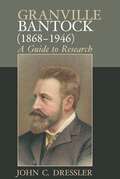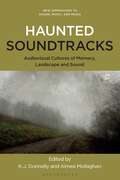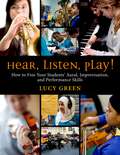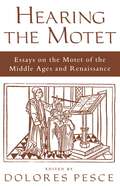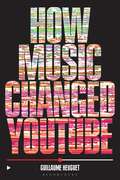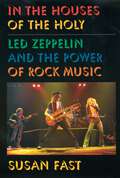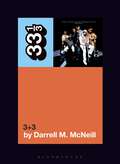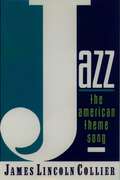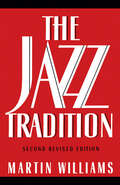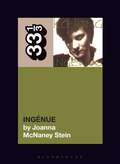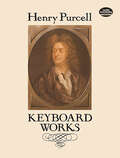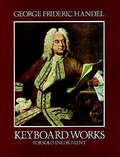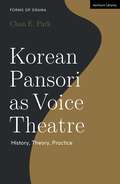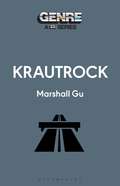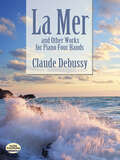- Table View
- List View
Granville Bantock: A Guide to Research (Clemson University Press)
by John C. DresslerThe book will contain location and descriptive details of Bantock's manuscripts that are extant, which will assist those looking to construct editions of those works which have remained in manuscript and updated editions of those works which were initially published nearly 100 years ago. A discography provides insight into the wide variety of recording companies that first served Bantock’s music. It also includes more recent and more highly refined recording sonics that help listeners hear these works in a much more solid balance and quality of sound than the multitude of 78 rpm recordings which form the initial recordings of any of Bantock’s pieces. Included in the book are sections which highlight academic theses and dissertations that discuss some of Bantock’s works. In addition citations of locations of many of Bantock’s letters still available for study are included. An index that cross-references all of these details to the works which they highlight is a major help to the reader.
Haunted Soundtracks: Audiovisual Cultures of Memory, Landscape, and Sound (New Approaches to Sound, Music, and Media)
The turn of the millennium has heralded an outgrowth of culture that demonstrates an awareness of the ephemeral nature of history and the complexity underpinning the relationship between location and the past. This has been especially apparent in the shifting relationship between landscape, memory and sound in film, television and other media. The result is growing interest in soundtracks, as part of audiovisual culture, as well as an interest in the spectral aspects of culture more generally. This collection of essays focuses on audiovisual forms that foreground landscape, sound and memory. The scope of inquiry emphasises the ghostly qualities of a certain body of soundtracks, extending beyond merely the idea of 'scary films' or 'haunted houses.' Rather, the notion of sonic haunting is tied to ideas of trauma, anxiety or nostalgia associated with spatial and temporal dislocation in contemporary society. Touchstones for the approach are the concepts of psychogeography and hauntology, pervasive and established critical strategies that are interrogated and refined in relation to the reification of the spectral within the soundtracks under consideration here.
Hear, Listen, Play!: How To Free Your Students' Aural, Improvisation, And Performance Skills
by Lucy GreenHearing Double: Jazz, Ontology, Auditory Culture
by Brian KaneWhen we talk about a jazz "standard" we usually mean one of the many songs that jazz musicians repeatedly play as part of their core repertoire. But unlike musical works in the tradition of so-called classical music, standards--whether plucked from the "Great American Songbook" or from recordings by other jazz musicians--are always being transformed in performance. They are rearranged and improvised upon, given new chords and altered melodies. These transformations might be small and seemingly unimportant, or they might be radical revisions. Which raises the question: across all of these various performances, what gives a standard its identity? In Hearing Double author Brian Kane answers that question by offering a new theory of musical works that can account for the unique challenges presented by standards. Building from the bottom up--from the actual practices of jazz musicians toward their philosophical implications--he gives a comprehensive theory of how a standard can undergo radical musical transformations yet remain identifiable. Through an analysis of the historical and cultural conditions under which standards came to prominence he shows how popular music from the 1930s to the 1960s was circulated and distributed and provides new insight into why the era of the standard emerged when it did. In addition, Kane addresses the aesthetic significance of standards and describes a special mode of listening that standards require. According to Kane, we effectively "hear double"--hearing an ideal song in our minds at the same time as we hear the live performance with our ears. Filled with case studies and music analysis, Hearing Double will draw the reader's attention to unheard aspects of jazz performance as well as unrecognized philosophical, social, and cultural dimensions of the jazz repertoire.
Hidden Treasures: Cultural, Social and Political Commentary in Mahler’s Songs from Des Knaben Wunderhorn (Clemson University Press)
by Molly BrecklingGustav Mahler once said, “With song you can express so much more in the music than the words directly say. The text is actually a mere indication of the… hidden treasure within.” Over fourteen years, from 1887-1901, he devoted his compositional output almost exclusively to texts and ideas drawn from a collection of German folk poetry entitled Des Knaben Wunderhorn: Alte deutsche Lieder, resulting in twenty-four songs which heavily inspired his first four symphonies. This study explores Mahler’s songs based on this poetry and identifies the connections the composer found between these products of Germany’s folk past and his own contemporary environment. The songs he created comment on and engage with Vienna’s musical life, Freudian theory, Mahler’s religious life, his family relationships, his views on women and romance, economic inequality, and wartime violence. As remnants of a folk tradition, the poems contained in Des Knaben Wunderhorn served the purpose of instructing young people on ways of conducting themselves, just as fairy tales do today. Mahler’s adaptation of these stories and his updating of them to serve audiences of his own time demonstrate the universality of the lessons these poems provide, both to audiences of Mahler’s day, and also to our own.
Holy Brotherhood: Romani Music In A Hungarian Pentecostal Church
by Barbara Rose LangeHoly Brotherhood: Romani Music in a Hungarian Pentecostal Churchis a musical ethnography of a religious community. After the end of socialism, different ethnic groups in Hungary harbored antagonism toward one another. In one Pentecostal church in Pecs, Hungary, however, both Hungarians and Roma (Gypsies) worshipped and made music together. Three musical repertoires coexisted, each with a separate historical background and complex social meanings: Romani religious song; nineteenth-century gospel hymns originally from the United States; and contemporary Christian pop from the United States. Church members accommodated cultural and musical differences by developing several distinct performance styles.
How Music Changed YouTube
by Dr. Guillaume HeuguetHow do digital technologies transform music? The answer depends on the lens of one's analysis: creation, promotion, or the experience of the listener. How Music Changed YouTube shows that the reverse question – How does music transform digital technologies? – is also worth exploring: through reliance on sound recording and music, internet technologies and media are manufactured, transformed, and come to dominate.Guillaume Heuguet's study situates YouTube in relation to both the internet platform and music industries by unpacking the cultural and technological forms embedded within and observing the practices and values associated with it, from the art of collecting to the accelerated circulation of samples and remixes. Heuguet's documentary and genealogical work relies on YouTube's traces in internet archives, its successive interfaces, the blogs of its teams, and a few emblematic channels and videos. Particular attention is paid to the tensions between the promises associated with music algorithms - recommendation system, copyright control, view calculation - and the reality of their operation from a technical and cultural point of view. How Music Changed YouTube shows how, far from responding to an immediate need, YouTube's editorial and economic model developed over time, how the various fans, artists, labels, lawyers and legislators shaped the site, and how these factors affected its rise as a global media force in the early 21st century.
Immaculate Sounds: The Musical Lives of Nuns in New Spain (Currents in Latin American and Iberian Music)
by Cesar D. FavilaIn Catholic doctrine, the Immaculate Conception of the Virgin Mary is the belief that Mary, the mother of Christ, was exempt from original sin from the moment of her conception, and thereby a co-redeemer alongside her son. Praise for this complicated devotion took place in Europe throughout the medieval period and resounded in the Americas with the founding of the first convent in Mexico City under the Order of the Immaculate Conception in 1540. All other orders of nuns in New Spain branched out from this convent, spreading the Marian devotion throughout the region. In this book, author Cesar D. Favila argues that the sonification of virginity and the Virgin Mary was fundamental to the promotion of the Immaculate Conception doctrine, and that this was part of a complex network of sonified practices in the lives of New Spanish nuns. These "immaculate sounds," a term Favila uses for the cloistered nuns' idealized vocalizations as well as the expression of doctrinal rhetoric through musical metaphors, echoed the highly regulated realm of the convent and played a pivotal role in mediating between the lives of New Spanish nuns and the expectation that they would save the secular world with their vocalized prayers. In addition to the sonification of discipline, Favila shows that immaculate sounds also enhanced the nuns' engagement with their religious practices and facilitated embodied and spiritual engagement with Catholic doctrines. Throughout his study, he delves into rarely studied music sources from seventeenth- and eighteenth-century New Spain alongside the rulebooks, devotional literature, and nuns' biographies that regulated convent life and inspired nuns' hymns. In doing so, Favila brings together a narrative of salvation that shines a light on the musical lives of nuns and locates women's agency within a hierarchical society that silenced some women and required others to sing. This is an open access title available under the terms of a CC BY-NC-ND 4.0 International licence. It is free to read on Oxford Academic and offered as a free PDF download from OUP and selected open access locations.
Insurgent Fandom: An Ethnography of Crowds and Unruly Sounds
by Max JackInsurgent Fandom offers a behind-the-scenes look at a transnational subculture known to few--ultra. As the most dedicated soccer fans, ultras support their team through collective singing, jumping, flag-waving, and lighting marine flares. While some characterize ultras as hooligans, author Max Jack argues that ultras' performative style of support is in part a protest informed by the ultras' constant friction with the state, the mainstream media, and the commercial priorities of sports' governing bodies. Because of this conflict with authority, fandom for ultras takes on a collective social life in which the game on the field often becomes a secondary concern. With political implications extending past the realm of sports, ultras have even become key actors in some of the most significant mass protests of the 21st century-including those in Cairo (2011), Istanbul (2013), and Kiev (2013). Insurgent Fandom embraces this politic of dissent at the heart of crowd action and casts a light on stadia as a breeding ground for alternative social and political possibilities.
The Isley Brothers' 3+3 (33 1/3)
by Darrell M. McNeillThe Isley Brothers' 3+3, dissects The Isleys' 50-year-old undisputed masterwork, an album that firmly established their music dynasty on a global scale, as well as heralding the boldest run of genre-defiant albums of their 67-year career. The 1973 watershed was their first multiplatinum release and is significant as a rare, crossover record by a Black act that struck a chord with urban, rock, and pop consumers, despite the schisms between audiences due to bias-driven media and industry marketing.The book looks at the album from all angles: from The Isleys' early career to their influence on rock and rollers both Black and White, from the twists and turns of having national hits without national recognition, on to their decision to form T-Neck Records and the group's challenges navigating a music industry that racially codified music and hampered Black artists from universal acclaim and compensations. Finally, a summation of the decades follows The Isleys' run and its ups and downs, with a fast-forward to where the group is now after 67 years.
J. S. Bach: The Organ Works
by George B. StaufferIn the obituary that appeared soon after his death, Johann Sebastian Bach was described as "the world-famous organist" and "the greatest organist...we have ever had." In Hamburg, Dresden, and other big cities, Bach dazzled audiences with his organ playing, performing passages with his feet that many thought impossible for the hands. One eyewitness declared that he had never seen anything like it. His extant organ works--more than 250 chorale settings and free pieces--are filled with bold, dramatic passages and fully independent pedal parts. They represent the most important body of music in the organ repertoire and the only genre that Bach turned to continuously throughout his life, from his earliest efforts as a teenager in Ohrdruf to his final deathbed revisions as a cantor in Leipzig. In this new survey, leading musicologist George B. Stauffer traces the evolution of Bach's organ works within the broad spectrum of his development as a composer. With detailed discussions of the individual pieces, the book shows how Bach initially drew on contemporary models from Germany and France before evolving a personal idiom based on the concertos of Antonio Vivaldi. In Leipzig, he went still further, synthesizing national and historical styles to produce cosmopolitan masterpieces that exude sophistication and elegance. Serving as a backdrop to this growth was the emergence of the Central German pre-Romantic organ, which inspired Bach to write pieces with unique chamber-music, choral, and orchestral qualities. Stauffer follows these developments step-by-step, showing how Bach's unending quest for novelty, innovation, and refinement resulted in organ works that continue to reward and awe listeners today.
J. S. Bach's Great Eighteen Organ Chorales
by Russell StinsonOn the 250th anniversary of the composer's death, this volume offers an in-depth look at the "Great Eighteen" organ chorales, among the most celebrated works for organ, and a milestone in the history of the chorale. Addressed to organists, scholars, and general listeners alike, this lucid and engaging book examines the music from a wide spectrum of historical and analytical perspectives. Stinson examines the models used by Bach in conceiving the original pieces, his subsequent compilation of these works into a collection, and his compositional process as preserved by the autograph manuscript. Himself an accomplished organist, Stinson also considers various issues of performance practice and concludes with a discussion of the music's reception--its dissemination in manuscript and printed form, its performance history, and its influence on later composers. Completely up-to-date and presenting a wealth of new material, much of it translated into English for the first time, this study will open up fresh perspectives on some of the composer's greatest creations.
Jazz Migrations: Movement as Place Among New York Musicians (American Musicspheres)
by Ofer GazitSince the 1990s, migrant musicians have become increasingly prominent in New York City's jazz scene. Challenging norms about who can be a jazz musician and what immigrant music should sound like, these musicians create mobile and diverse notions of jazz while inadvertently contributing to processes of gentrification and cultural institutionalization. In Jazz Migrations, author Ofer Gazit discusses the impact of contemporary transnational migration on New York jazz, examining its effects on educational institutions, club scenes, and jam sessions. Drawing on four years of musical participation in the scene, as well as interviews with musicians, audience members, venue owners, industry professionals, and institutional actors, Gazit transports readers from music schools in Japan, Israel, and India to rehearsals and private lessons in American jazz programs, and to New York's immigrant jazz hangouts: an immigrant-owned music school in the Bronx; a weekly jam session in a Haitian bar in central Brooklyn; a Colombian-owned jazz room in Jackson Heights, Queens; and a members-only club in Manhattan. Along the way, he introduces the improvisatory practices of a cast of well-known and aspiring musicians: a South Indian guitarist's visions of John Coltrane and Carnatic music; a Chilean saxophonist's intimate dialogue with the sound of Sonny Rollins; an Israeli clarinetist finding a home in Brazilian Choro and in Louis Armstrong's legacy; and a multiple Grammy-nominated Cuban drummer from the Bronx. Jazz Migrations concludes with a call for a collective reconsideration of the meaning of genre boundaries, senses of belonging, and ethnic identity in American music.
Johann Sebastian Bach's Goldberg Variations Reimagined
by Erinn E. KnytThis book provides the first detailed reception history of adaptations of Johann Sebastian Bach's Aria mit 30 Ver?nderungen (Goldberg Variations, BWV 988). It documents multiple ways Bach's work has appeared in arrangements, transcriptions, and re-compositions from 1800 to 2020. It examines adaptations for the traditional concert hall as well as for dance, theater, cinema, literature, digital media, and visual art. Overall, the book reveals a dramatic increase in adaptations of the piece in the late twentieth and early twenty-first centuries. In addition, it brings the reception history of Bach's Goldberg Variations into dialogue with broader scholarly discourse about performance practice issues. The piece was often performed in transcribed or arranged versions in the nineteenth century and then again in the late twentieth and early twenty-first centuries. Yet if nineteenth-century adaptations of this piece were usually created out of necessity, as a means of performing a lengthy piece without access to the original instrument, many twenty-first century adaptations, which have developed alongside historically informed performances, were motivated by deconstructionist ideologies. This contrasts with the middle part of the twentieth century, when there was a prevalence of historically informed performances and a dearth of adaptations. Comparisons to other works by Bach reveal similar performance practice trends. The reception history documented in the book also considers the musical work concept. It shows that, particularly since the late 1980s, there has been a loosening of the regulative hold of the modernist work concept associated with single authorship, structural unity, and an autonomous score. It reveals that many recent adaptations are not direct interpretations of an authoritative text, but engage in multivalent dialogues as Bach's score becomes an infinite or open text in which multiple people, including subsequent (re)-composers, performers, directors, and audience members enter into inter- and intra-textual conversations. In the process, the book contributes to recent studies about adaptations, the role of musical authorship, and changing notions of Bach and the work concept in the twenty-first century. At the same time, it discusses many recently composed pieces, including ones by underrepresented composers.
k.d. lang's Ingénue (33 1/3)
by Joanna McNaney SteinCanadian performer k.d. lang broke new ground in the 1980s by blending the genres of punk and country, dubbed “cowpunk,” with her band, the Reclines. Despite Grammy-award-winning recordings and frequent North American TV spots, mainstream country radio excluded lang from airplay due to her unconventional gender presentation and perceived sexuality. Not until lang's 1992 pop album Ingénue, the release of the single “Constant Craving,” and her subsequent coming out in The Advocate did lang earn critical acclaim worldwide. The book addresses lang's rise to fame after switching genres, the successful reinvention of her sound and persona, and how she found herself immersed in the whirlwind of MTV and the "lesbian chic" aesthetic of 1990s pop culture. As an LGBTQ author, Joanna McNaney Stein discusses her adolescence and sexual development by weaving in short narrative prose pieces with her analysis of lang and Ingénue. Also included are interviews with lang's musical collaborators: Ingénue co-writer Ben Mink, drummer Fred Eltringham, pianist Daniel Clarke, and singer-songwriter Laura Veirs.
Keyboard Works
by Henry PurcellRenowned for the originality of his music and his gifts as a melodist, Henry Purcell (1659-1695) was the preeminent English composer of the seventeenth century and one of the greatest that nation has ever produced. His gifts are apparent not only in the vocal and orchestral works on which his fame rests, but in his delightful keyboard music, much of which is relatively simple and easy to perform. This volume is a near-complete collection of Purcell's keyboard compositions, including the eight suites, the core of his keyboard works. Also included are many miscellaneous one-movement pieces: airs, trumpet tunes (for harpsichord solo), grounds, preludes, dances, etc.Piano students and pianists of intermediate skills will enjoy these pieces for their charm and accessibility. Gathered here in one convenient, inexpensive volume, they offer a treasury of time-honored music that musicians and music lovers will turn to again and again.This volume has been edited with a preface by the noted music scholar William Barclay Squire.
Keyboard Works for Solo Instrument
by George Frideric HandelThe music historian Sir John Hawkings recorded that his friend Handel's keyboard improvisations "stole on the ear in a slow and solemn progression; the harmony close wrought, and as full as could be possibly be expressed; the passage concatenated with stupendous art, the whole at the same time being perfectly intelligible, and carrying the appearance of great simplicity." Such fecund spontaneity generated the few published pieces Handel wrote specifically for the keyboard. The first set of suites appeared in 1720, perhaps composed and published for the instruction of Princess Anne, to whom Handel serves as music master. Other collections of harpsichord and clavichord work followed; all seem to have been preserved from Handel's freely inventive keyboard sessions. Here, for the first time in a popularly accessible edition, are 35 of his finest keyboard works for solo instruments, reproduced from the monumental Deutsche Händelgesellschaft edition, still the most complete.This collection features the celebrated Eight Great Suites, including the Harmonious Blacksmith Air and the Passacaille in G Minor (G 255), "a work in which Handel approaches most nearly to the monumental style of his choral writing" (Grove's Dictionary). Other works include: Fugue in A Minor; Fantasia in C Major; Suite (Partita) in G Minor; Sonatina in B-flat Major; Capriccio in F Major; Minuet in G Minor; Sonatas in C Major; Chaconne in F Major; Prelude and Sonata in G Minor; and more.For this new edition, the pieces have been rearranged and retitled according to the latest scholarly sequences found in The New Grove Dictionary of Music and Musicians. Students and scholars will find many of the ideas Handel sketched here expanded and reworked in later chamber and orchestral works and in the opera dance movements; musicians and every Baroque music lover will see in these neglected pieces "a Protean fluidity" (New Grove) worthy of the great composer, and more than worthy of any musical library.
Korean Pansori as Voice Theatre: History, Theory, Practice (Forms of Drama)
by Chan E. ParkThis book introduces readers to the historical, performative, and cultural context of pansori, a traditional Korean oral story-singing art. Written by a scholar-practitioner of the form, this study is structured in three parts and begins by introducing readers to the technical, aesthetic, and theoretical components of pansori, as well as the synthesis of vocal and percussive elements that stage the narrative. It moves on to reflect on the historical contexts of pansori, alongside Korea's transformation from Joseon monarchy to modern statehood. It argues that with colonial annexation came modernist influences that Korean dramatists and audiences used to create new genres of performance, using the common thread of pansori. The book's third part explores the interplay of preservation and innovation, beginning in the post-war period and continuing with developments in the 20th and 21st centuries that coincide with Korea's imprint on cultural globalization. Along with Korea's growth as a world economic center, a growing enthusiasm for Korean culture around the world has increased the transmission and visibility of pansori. This study argues that tradition and innovation are not as divergent as they are sometimes imagined to be and that tradition is the force that enables innovation. Drawing on Chan E. Park's ethnographic work and performance practice, this book interweaves expert knowledge of both the textual and performative aspects of pansori, rendering legible this dramatic tradition.
Krautrock (Genre: A 33 1/3 Series)
by Marshall GuKrautrock is not a music genre. Krautrock is a way of life. Its sonic diversity and global reach belie the common culture from where it emerged. This is a band-by-band history. In May 1945, the Allies defeated Nazi Germany, putting an end to the European front of World War II and the Third Reich. In the immediate aftermath, German youth were tasked to create their own culture. Krautrock is this unlikely success story, as hundreds of bands-including Kraftwerk and Can-seemed to sprout overnight in the early 1970s, forging a unique and experimental sound that was different than American or British rock. The major innovation of krautrock is not only its motorik beat, the steady click-click of Can's Jaki Liebezeit or monolithic stomp-stomp of Neu!'s Klaus Dinger, but also how the musicians relate to each other. In krautrock, no musician is given more focus than any other, and listening to these bands is to witness interplay common in jazz music. Thus, krautrock represents German politics reflected in music: a dictatorship replaced by democracy. Krautrock explores the history and methodology of the genre, charting its influences and innovations, its more mainstream acts (like Faust, Kraftwerk, and Can) as well as the less universally known (including Harmonia, Popol Vuh, Embryo, and Ash Ra Tempel), and how the genre developed in post-war Germany and what it means to today's listeners.
La Mer: And Other Works for Piano Four Hands
by Claude DebussyLike his predecessor Chopin, Debussy discovered new possibilities and refinements in the art of playing and composing for the piano. His compositions and transcriptions for piano four hands are among his most inventive and interesting works. This volume contains Marche Ecossaise, written specifically for piano four hands, and the composer's transcription for four hands of La Mer. These works display both the brilliant pianism at the heart of Debussy's musical imagery and the composer's affinity for the unexpected -- a quality that allowed many of his compositions to unfold like highly sophisticated improvisations. Reprinted here from authoritative French editions, they will challenge and delight pianists with their unique qualities.
